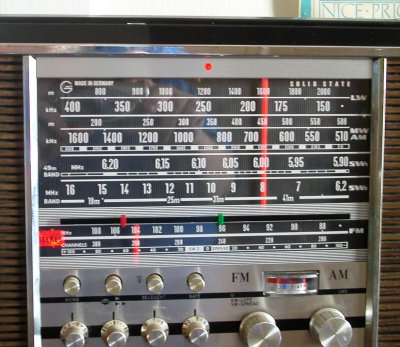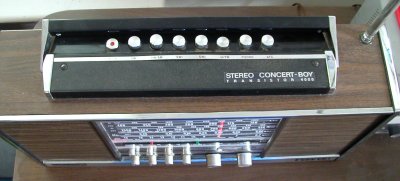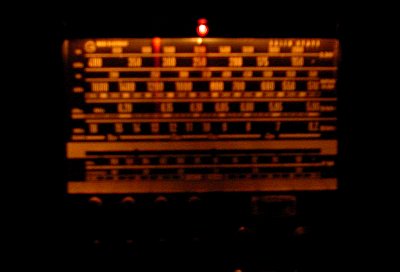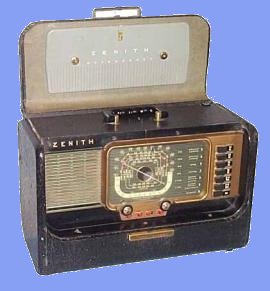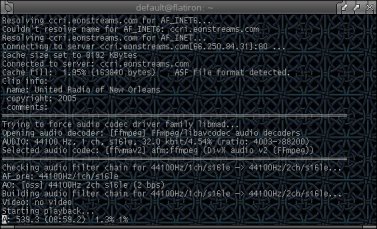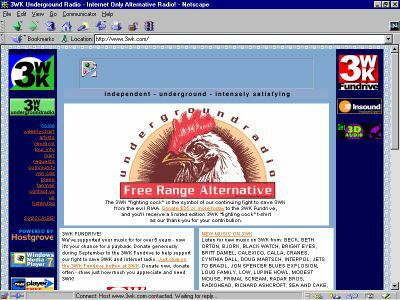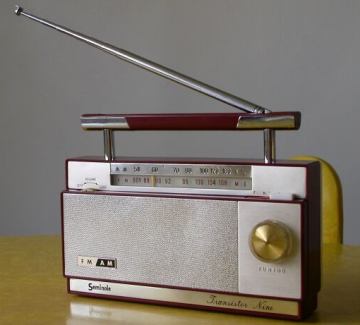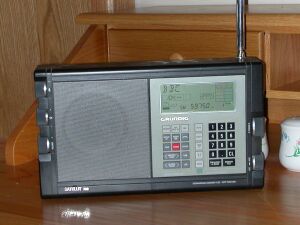Winter is the time of year when those voices from afar come in especially strong over your radio. I remember the winter of 1968 and 1969. I was 12 years old. And upstairs in a dimly lit back room, I would sit at table, tuning carefully up and down the radio dial. Tuning in search of elusive distant radio stations. Tuning to hear voices that could sometimes barely be heard above the hiss and crackle of static.
The radio was an old Stewart-Warner— it was older than I by a good margin— dark bakelite box of a cabinet, bronzed metal grille across the front, and two knobs. At lower left, the
On/Off/Volume knob; at lower right, the AM tuning dial, running from 5
5 to 16. It was a tube radio; when you turned it on, it would take a little while to warm up before you heard that dark electric hum from the speaker grille.
Of course, it was easy to tune in the local radio station, WIBU 1240 Poynette, Wisconsin. That was a loud signal, not because it was powerful— I believe it was only 250 watts by night— but because it was nearby, up on top of WIBU Hill, outside of town. Tuning up the dial a bit further, it was also easy to receive WPDR 1350 from Portage, 12 miles to the north of us.
Then there were the stations in Madison, Wisconsin, just 20 or 25 miles to the south of us. Oldtimers from the Madison area may remember the call letters, which for some of the stations have changed since then: WHA 970, the public station; WKOW 1070, which I recall had a talk radio program called "Night Line," long before talk radio became popular; WIBA 1310; WISM 1480; and WMAD 1550.
Milwaukee was about 90 miles to the east of us, and from there WTMJ 620 came in loud and clear day or night— I believe the call letters stood for
The Milwaukee Journal, for which I had a paper route in my home town back around that time. If you were lucky (and here I'm guessing from memory at the frequencies) you could also get WOKY 920 and WISN 1120 from Milwaukee. And there was WYLO 540 Jackson, which I always took to be somewhere over by Milwaukee: I used to get a shiver up my spine receiving this station, the lower part of the radio dial for some reason had that effect on me.
Which brings us to another point: listening to these stations over the radio felt to me then— it still feels to me today— like entering some strange new dimension, like connecting with some alternate level of reality. I never knew quite what I was going to find, tuning that old bakelite radio in that dimly lit upstairs room on a cold winter night.
The Chicago stations also came in clearly day or night. WMAQ 670; WGN 720; and of course WBBM 780, "News Radio 78," were all news stations. WLS 890 came in also, but less clearly: they were at that time a music station, if I remember correctly, and popular with some of my friends. When I rediscovered WLS in the mid 1980s, when I was living down in Illinois, they had gone to a news-talk format, though at that time they still interspersed some music with the talk. The Chicago stations WCFL 1000 and big-band-music WAIT 820 came in much more faintly, when they came in at all. And then there was also WIND 560 Gary Indiana, another of those eerie stations down near the bottom of the dial— to me, the furthest radio outpost before we entered into the Ultima Thule of nighttime DXing.
Winter nights I would sit there listening to WMT 600 Cedar Rapids, Iowa; or WCCO 830 from the Twin Cities. There was WHO 1040 Des Moines: I was fascinated by these occasional stations west of the Mississippi which started their call letters with a
W. It was sort of like those stations out east which started with a
K, KDKA 1020 Pittsburgh and KYW 1060 Philadelphia. I entertained fantasies of tuning in some forgotten station which started with a
really odd wrong letter: not just some station in Texas which (like a Mexican station) might start its call letters with an
X, but perhaps a station out in Nebraska, say, whose call letters might start with an
R. At 12 years of age, anything seems possible.
Tuning down the Mississippi, it was possible at night to receive KSD 550 St. Louis, which I find listed in my notes as "Audio 55"; KMOX St. Louis (frequency?); or WWL 870 New Orleans, "broadcasting from the Roosevelt Hotel in downtown New Orleans." In between, one might pick up WAAY 1090, Little Rock, Arkansas.
Or aiming eastward, there was WHAS 840 Louisville, Kentucky; or WLW 700 Cincinnati. Turning south into Tennessee, Nashville had both WSM 650 and WLAC 1510. There was WJR 760 Detroit, and just below it on the dial, CBL 740 Toronto. And from the Southeast, it was easy at night to receive WSB 750 Atlanta.
Out East, I could pick up WHAM 1180 Rochester, New York. Also 810 WGY Schenectady. And WCAU 1210 Philadelphia. And WRVA 1140 Richmond, Virginia. I remember getting WABC 770 and WOR 710 New York, but somehow back in those days I didn't often receive other clear channel stations from New York City— WCBS 880 and WNBC 660. But I do remember WBZ 1030 Boston coming in loud and clear.
Turning the radio to face various shades of southwest and westward— the ferrite rod antenna inside was fairly directional— I would get stations from the wide open spaces out West. I can still remember the jingle to which they sang "WOAI, San Antonio"— yeah, WOAI 1200. From Texas there was also WBAP 820 Fort Worth/Dallas. And for some reason it was always a special thrill to receive KOA 850 Denver— "KOA 850, the Timekeeper!"
The Rocky Mountains seemed to form a barrier to radio propagation. I never had any luck getting a station further west than Denver. Yeah, from up in Canada I could get CKY 990 Winnipeg, and maybe some station from Calgary. But never anything from the West Coast. In the early 1980s, when I was living out in Washington State, I noticed a similar phenomenon in reverse: out there, I could get stations from all up and down the Pacific Coast, but never a station from east of the Rockies.
The stations I've listed so far are all the big powerhouses, the blowtorches, or the 50-kilowatt clear channel stations. I'm listing them from memory, aided by a pamphlet I drew up back then which I ran across just the other day. Somewhere around here there's an old brown spiral notebook: if I can ever find that, I'll be able to list many of the softer and more elusive voices I used to hear over that radio.
I remember one station, broadcasting at only one kilowatt, from down near the bootheel of Missouri: I got them one day just as they were signing off at sunset. It was my first introduction to the phenomenon of radio stations carrying unsightly distances north and south right at sunrise or sunset. I wrote them, giving details of what I heard, and got back from them a letter verifying that I had indeed received them. As per my request, they agreed to play
On, Wisconsin for me on their station.
And then, down in the magical lower ranges of the radio dial, there was the time I received WILL 580 Urbana, Illinois. I can still hear that station, its choppy signal rising and falling rhythmically in a sea of radio static, and amidst the static, half drowned, the strains of
Sweet Blindness and
Stoned Soul Picnic.
And sometimes I would listen to distant voices which were nearly submerged in the static and the radio hum, unintelligible, too far off, a hubbub of voices, like something heard but not understood in the background of the Beatles'
Revolution 9.It was magic, it was truly magic, listening to those far distant voices up and down the radio dial. Like eavesdropping on some other level of reality.
Labels: best_of, doors_of_perception, radio


